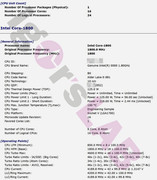 05.05.2021., 09:39
05.05.2021., 09:39
|
#4473
|
|
McG
Datum registracije: Feb 2014
Lokacija: Varaždin
Postovi: 8,546
|
Exclusive info about Intel’s Alder Lake-S – Will the Intel Core-1800 be a threat to AMD?
Citiraj:
Intel wants and needs to set with Alder Lake as 12th generation a big mark in the mainstream market for desktop CPUs this year, if they don’t want to lose the connection (also from their target group’s point of view). And it is not only a repainted and further upgraded 14 nm CPU, but in addition to the smaller structure width of 10 nm (according to Intel’s reading), it is finally also a completely new architecture with a completely different solution approach. In the ES of the Core-1800 in the (not final) B0-stepping presented today, there are 8 large Golden Cove cores (Core) and 8 small Gracemont cores (Atom) on the die. While the big cores are also capable of hyperthreading, this is not the case with the Atom cores. In total, you’ll find 16 cores that can process a maximum of 24 threads. According to various leaks, Intel quantifies the performance leap compared to a conventional solution (unfortunately not specified) with up to 20 percent in pure single-thread scenarios and a doubling of the multi-thread performance in the ideal case, which seems quite optimistic when you consider a current 8-core of the 11th generation.
The processor, internally called Intel Core-1800, sits in the new Socket V (LGA 1700) and has a TDP of 125 watts. The screenshot below, which I modified slightly to protect the source, shows a time of 56 seconds for the PL1 and a peak time of 2.44 ms for the PL2 of a whopping 228 watts. That this up- and down-switching is well suited to aggravate the already nervous load change behavior of the current Intel CPUs even more doesn’t even have to be mentioned. This is where the voltage converters of the mainboards come into play. The revision B0 of this ES is still quite early and the base clock is also still quite low with only 1800 MHz. More interesting are the Turbo Boost limits of the big cores, where 1-2 cores are already supposed to reach 4.6 GHz, with 3-4 cores it’s still 4.4 GHz, with 5-6 cores 4.3 GHz and with all 8 cores then 4 GHz. The small Atom cores clock with up to 3.4 GHz with <=4 used cores, otherwise only with 3 GHz.
According to the initial information, the new desktop CPUs will support up to dual-channel DDR5-4800 memory and the DDR4-enabled motherboards will support modules up to 3200-MHz.
Supposedly, only the high-end Z690 motherboards will offer DDR5 support, while all cheaper variants will still rely on DDR4. 
|
Izvor: Igor's Lab
|

|

|